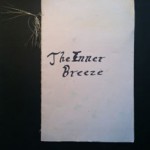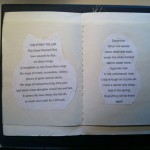by Cedar Brant, Colorado Review editorial assistant
The most shocking thing happens when your work is published: people read it. Although this is, of course, the basic idea, it is nonetheless miraculous. Publication is the crucible that transforms the private tomes of one’s journal into, in the spirit of John Keats, “a handshake,” an act of communication.

 My impulse to publish my poems as a kid led to my first book, Kasana— The Inner Breeze, scribed by hand and sewn with golden thread. It was a very limited run. My next set of poems was ready to go in college. There was no undergraduate literary journal at my college, so again (this time with the help of a word processor) I sewed pages of poems together and sent them off—to my mom.
My impulse to publish my poems as a kid led to my first book, Kasana— The Inner Breeze, scribed by hand and sewn with golden thread. It was a very limited run. My next set of poems was ready to go in college. There was no undergraduate literary journal at my college, so again (this time with the help of a word processor) I sewed pages of poems together and sent them off—to my mom.
Although these efforts fell short of the sort of connection I sought, I remained curious about that veiled space between the private work of my own writing and the intimate act of listening that I experienced while reading.
Although I had a few experiences with publications after college that did involve glue, even my first chapbook of poems was hand-bound. So when I entered halls of academia last year and became an intern for Colorado Review and the graduate advisor for the undergraduate literary journal Greyrock Review, I just may have had a thread and needle still in the back of my mind.
These publications have not, of course, involved any physical stitching. But this past year I have simultaneously worked with writers “publishing” in three distinct points in their writing careers: fourth-graders, undergraduates, and well-established writers publishing in Colorado Review.
The fourth-graders for whom I teach a poetry class once a week are often writing their first poems. It’s hard. But when I offer to read them at the end of class, they all hold their poems in the air. They want to share them, to hear the weird thought-tracks of their peers, and to offer their impressions on what the image of the Cyclops eating radishes in that poem of their peer is all about. Although the booklet of their best poems I’m putting together for them is not exactly publication, it is their first experience of writing what is in their own private minds and then having that act become one that is experienced by the whole class, by their community.
 Meanwhile, the undergraduate staff of Greyrock Review literary journal was busy putting together a journal of work by undergraduate students, many publishing in this more formal setting for the first time. Although it seemed at times we were forging through utter darkness (with me and my spool of thread at the helm), the finished journals arrived and we threw a party. At the release party, the contributors read their work. After months of working with these poems and stories on the page, hearing them read aloud brought the life into the journal: real people reading their real stories. It was a reminder that publishing is a project of the human, to find what is shared between us through this craft of language.
Meanwhile, the undergraduate staff of Greyrock Review literary journal was busy putting together a journal of work by undergraduate students, many publishing in this more formal setting for the first time. Although it seemed at times we were forging through utter darkness (with me and my spool of thread at the helm), the finished journals arrived and we threw a party. At the release party, the contributors read their work. After months of working with these poems and stories on the page, hearing them read aloud brought the life into the journal: real people reading their real stories. It was a reminder that publishing is a project of the human, to find what is shared between us through this craft of language.
Being an editorial assistant for Colorado Review has given me a glimpse of the volume of creative talent out there, of well-crafted poems exploring the depth of every surface of the world. Reading poetry submissions for Colorado Review after my fourth-graders and Greyrock Review meetings, I felt I was catapulting through time, listening to the same voices grow and refine. Although the process of submission to publication is more complex at Colorado Review than in our fourth-grade class, the fundamental process is the same—everyone holds their poems in the air to be read.
Literature speaks across age and educational distinctions. The same poem can be moving to a nine-year-old, an undergraduate intern, and a Pushcart Prize–winner. It seems important that the relationship between reading and writing literature remain reciprocal. I feel lucky to be listening to these different groups of voices and working to bring those voices into the world of print, to become a shared thing.
The writers we publish at Colorado Review inspire me to keep writing, to keep sending my poem-handshakes out into the world. So do the voices of the young writers I have worked with this year, just beginning to build and weather their craft for the long journey of language ahead. Take this description of the soul from a fourth-grader in my poetry class in the local elementary school:
My soul shoots pure thought into the air,
freezing everything around it.
It is on the other side of the fire.
The other side of the ocean.
Opposite from the mountains.
Opposite from the sky.
Fast forward a decade and you get such insights as voiced by undergraduate Molly Davidson in her poem “Draft” (recently published in Greyrock Review 2015):
The group of writers fracture
language until my ribs, too,
crack from exhaling words
as sighs. Wind made into song
of instruments I do not know:
they bend the stillness of air
into storm. Because I have seen
an ash tree fall, and lost a river’s map
to the wind, I do not fight. Their
thoughts gust a window open;
six strings again being tuned after
practice drove dust away.
Not only is listening to these new voices through their respective publications inspiring, it also is teaching this next generation of writers to become readers of literary journals. If we are to ensure that poetry, short stories, and creative essays survive our culturally shrinking attention spans, we must expose young writers to the alchemy of publication, and the value of literary journals.
Publication bridges the gap between writing and the literature we read. Suddenly with their voices between the covers of a book, the act of becoming a writer is illuminated, as is the connection this act creates. Literary journals are a place of exchange, of making contact.
So I am celebrating the voices and efforts of everyone who put forth their work this year to support the act of publication, of contact. The work of publishing is important on every level. It brings forth new voices and teaches young and up-and-coming writers that both reading and publishing in literary journals is important stuff. It is this understanding of and participation in publishing that will keep the hearts beating in the chests of our literary journals for years to come. And this will be good for us all.